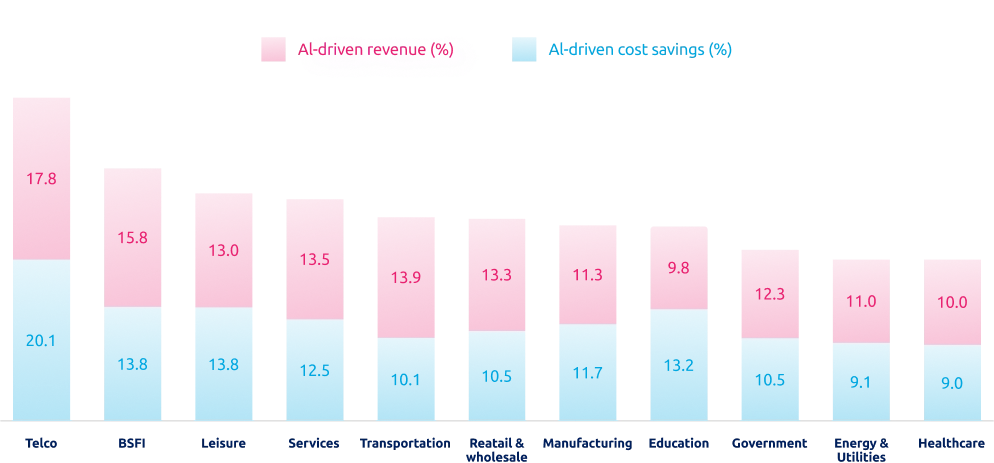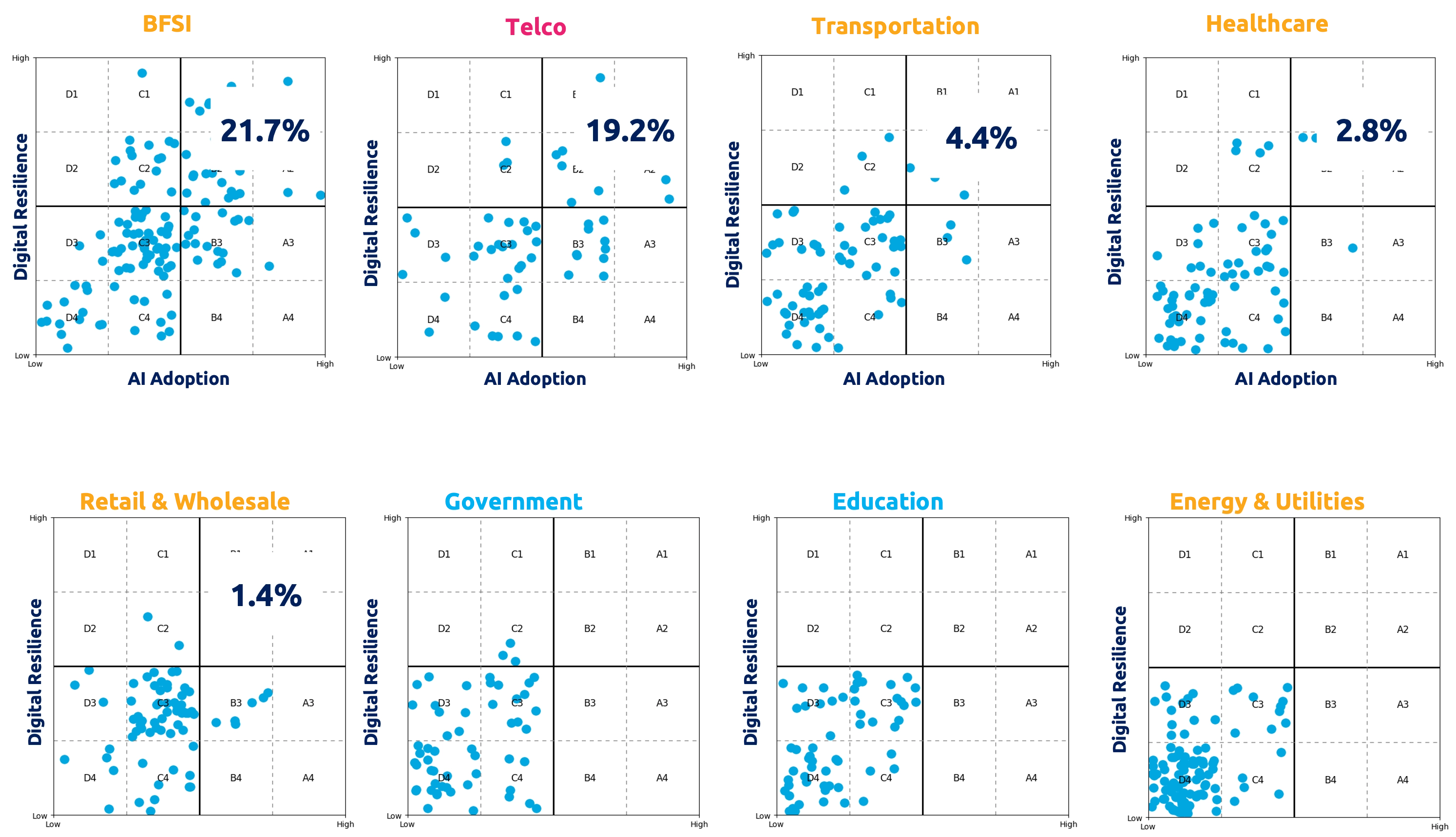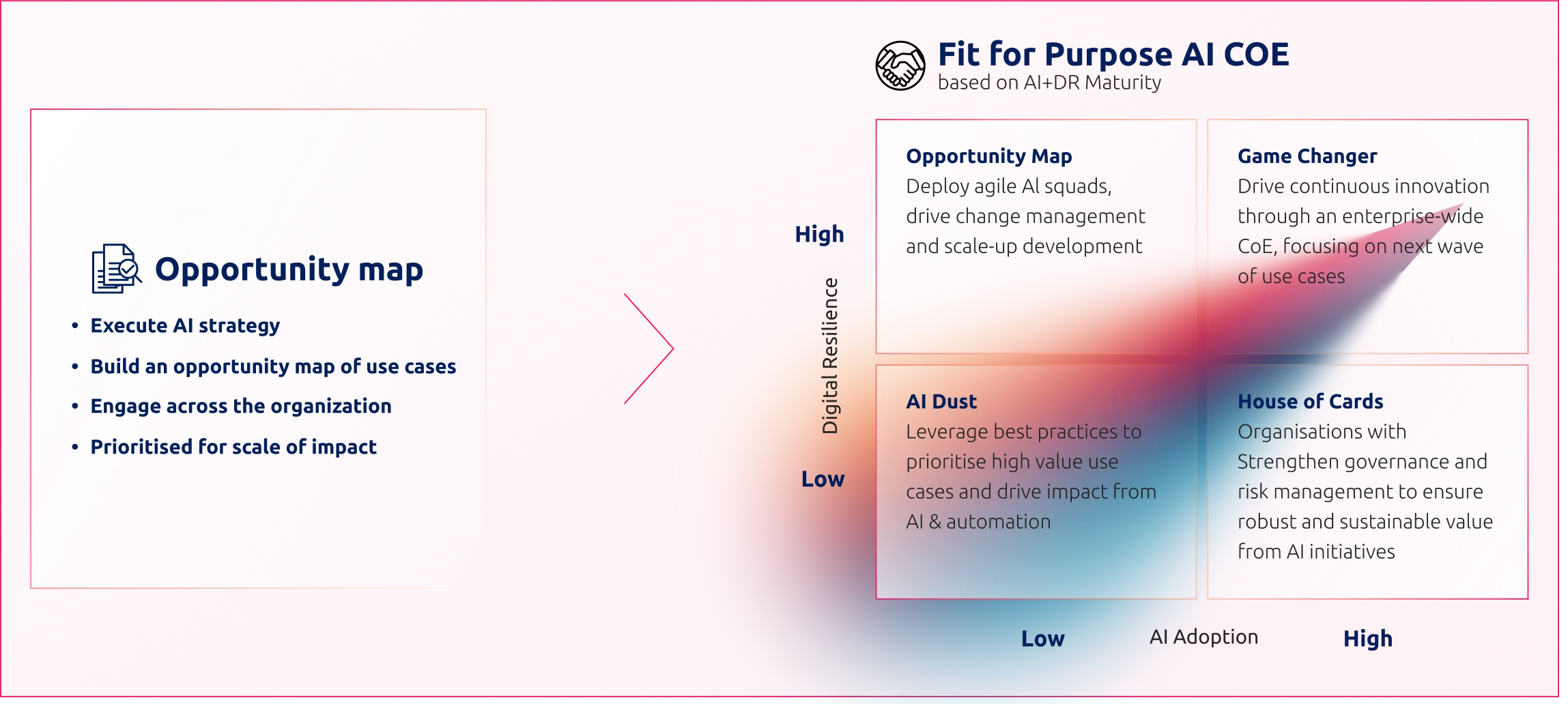Published: Oct 17, 2025
Digital Resilience: The grandmaster strategy to maximise your AI investment
Artificial intelligence is scaling fast, with global investment projected to hit $632 billion by 2028 (IDC, 2024). Yet for most organisations, AI remains “skin-deep”: exciting in pilots but difficult to scale profitably. An IDC study, sponsored by NCS, found that 80% of enterprises struggle to turn AI experiments into enterprise-wide impact.
The reason is clear: without digital resilience (DR), AI adoption buckles under the weight of legacy systems, fragmented data, and rising cyber risks. In the grand game of AI, resilience is the king that must be protected. Organisations that build strong DR foundations achieve 1.1× higher AI-driven revenue and 1.4× greater cost savings than their peers.
This article shows why DR is the cornerstone of sustainable AI, outlines the five critical dimensions of resilience, and shares how NCS helps organisations move from AI Dust to Game Changer.
Key takeaways
- Most organisations cannot scale AI beyond pilots into real business impact
- Digital resilience is the foundation that enables AI to deliver returns
- AI success relies on five dimensions: 1) Cybersecurity 2) Data Backbone 3) Applications Interplay 4) Infrastructure Robustness and 5) Operations Responsiveness
- Resilient companies achieve higher revenue, faster recovery from disruptions, and greater cost savings
- NCS provides the pathway with tools, services and strategies for enterprise-wide AI success
The challenge: AI’s strain on digital systems
Most businesses face major challenges scaling AI. Legacy infrastructure, fragmented IT environments, and tight budgets make it difficult to support high-performance workloads. Gartner reports that AI compute requirements double every 3.4 months, while Cisco projects global IP traffic will triple by 2025. These pressures overwhelm systems not designed for such demand.
Legacy technology compounds the issue. Forrester notes that 89% of businesses still depend on at least one legacy system, consuming up to 80% of IT budgets on maintenance. At the same time, as AI integrates diverse data sources, cybersecurity risks grow. Gartner estimates that the global cost of cybercrime will reach $10.5 trillion annually by 2025.
The challenges of AI adoption are not uniform; they vary significantly across industries, as revealed by the NCS–IDC global survey of 870 enterprises and government organisations.

Figure 1 AI-driven business value (%) across different Industries.
The solution: Strengthening digital resilience
The same survey also revealed a clear correlation between investments in DR and the extent of AI adoption. Organisations with stronger digital foundations demonstrated higher readiness and ability to scale AI initiatives effectively.

Figure 2. Positive correlation between extent of AI adoption and DR readiness.
Other insights from the survey showed:
- Over 80% of organisations are in the “AI Dust” quadrant — many pilots, but little scalable impact.
- Game Changers (6%) demonstrate both high AI adoption and DR readiness.
- BFSI is the early leader in adoption, while retail, wholesale, and leisure lag behind.

Figure 3. AI+DR Matrix (n=870). The AI+DR Matrix divides organisations into four quadrants: 'Game Changers' (6%) demonstrate high AI adoption and DR readiness, realising substantial business value. Conversely, 'AI Dust' (82.9%)—organisations with low maturity in both areas—struggle to scale AI effectively. The remaining groups, 'House of Cards' (5.6%) and 'Missed Opportunity' (5.6%), indicate partial strengths but face gaps that limit their AI potential.

Figure 4. AI+DR Matrix across leading industries. BFSI emerges as the clear leader, with 21.7% of organisations demonstrating high AI adoption and DR readiness. Meanwhile, sectors like Retail & Wholesale (1.4%) remain at the lower end, indicating a need for foundational investments to unlock AI's transformative potential.
Five dimensions of resilience
DR extends beyond traditional cybersecurity. It spans five critical dimensions that support AI at scale:
- Cybersecurity – advanced measures are needed to protect AI systems and data integrity.
- Data Backbone – secure, accurate, and compliant data flows are essential in the AI era.
- Applications Interplay – systems must perform under stress and adapt to changing conditions.
- Infrastructure Robustness – compute, storage, and network capacity must grow with AI workloads.
- Operational Responsiveness – processes must adapt quickly to disruptions and risks.
The survey highlights that organisations excelling in these areas — the Game Changers — outperform peers.

Figure 5. Comparison of AI-driven Business Value and Normalised AI and DR Element Scores Between Game Changers and AI Dust.
The outcome: From dust to game changer
To support organisations in enhancing their AI and DR readiness, NCS provides:
- A diagnostic tool to benchmark readiness and prioritise investments.
- A range of tailored service offerings to strengthen digital foundations and scale AI effectively.

Figure 6. NCS AI+DR service offerings.
Two strategic plays for long-term advantage
Turning AI ambition into enterprise-wide impact requires more than experimentation. Organisations need both a clear roadmap and the capability to execute at scale.
Two priority actions provide the foundation:
|
The Opportunity Map is a structured roadmap that identifies where AI can make the most significant difference across the business. Built with input from stakeholders across functions, it ensures alignment, buy-in, and shared ownership of the AI journey. By prioritising initiatives based on impact and feasibility, organisations can avoid scattershot pilots and instead focus on a sequence of moves that build momentum and deliver tangible value. |
The AI COE acts as the central hub for governance, talent, and best practices. It orchestrates initiatives across the organisation, ensuring lessons learned are captured and reapplied, and that maturity stages are navigated smoothly From establishing guardrails to enabling cross-functional collaboration, the COE provides the structure and adaptability needed to embed AI into the organisation’s DNA. |
Together, these steps provide both the plan and the organisational capability to scale AI with confidence. Like chess pieces with distinct roles, they can be deployed strategically to secure long-term advantage.
Winning the AI game requires protecting the king with resilience
AI has the power to transform industries, but only if it rests on a foundation of digital resilience. The NCS–IDC survey confirms that organisations with stronger resilience achieve higher returns, faster recovery from disruptions, and greater efficiency.
The five dimensions of resilience — 1) Cybersecurity 2) Data Backbone 3) Applications Interplay 4) Infrastructure Robustness and 5) Operations Responsiveness — form the backbone of scalable, secure, and sustainable AI. Companies that master these areas move from short-lived pilots to enterprise-wide impact, becoming true Game Changers.
For organisations still in the early stages, building resilience is not optional. It is the pathway to maximising AI investment and securing long-term competitiveness in the digital economy.
Reference
IDC, FutureScape: Worldwide Generative AI 2025 Predictions, 2024. Retrieved from https://info.idc.com/rs/081-ATC-910/images/US-IDC-FutureScape-2025-GenAI_ebook.pdf